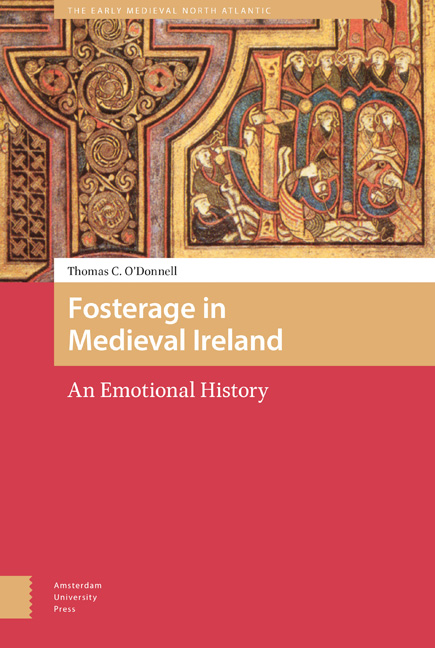Book contents
- Frontmatter
- Dedication
- Contents
- Abbreviations
- Acknowledgements
- Introduction
- 1 Cú Chulainn and Expressions of Foster Fatherhood
- 2 Who Makes a Foster Sibling?
- 3 Identity within Fosterage
- 4 Fosterage in the Medieval Irish Church
- 5 Animal Fosterage: A Bestial Parallel?
- Conclusion
- Bibliography
- About the Author
- Index
1 - Cú Chulainn and Expressions of Foster Fatherhood
Published online by Cambridge University Press: 25 November 2020
- Frontmatter
- Dedication
- Contents
- Abbreviations
- Acknowledgements
- Introduction
- 1 Cú Chulainn and Expressions of Foster Fatherhood
- 2 Who Makes a Foster Sibling?
- 3 Identity within Fosterage
- 4 Fosterage in the Medieval Irish Church
- 5 Animal Fosterage: A Bestial Parallel?
- Conclusion
- Bibliography
- About the Author
- Index
Summary
Abstract
This chapter introduces the concept of fosterage in medieval Ireland, who was fostered, by whom and the terminology that was used to express these relationships. How fosterage was practiced will have an effect on the emotions within fosterage were created and expressed. Taking the figure of Cú Chulainn as a case study, we see that maternal kin were usually used as fosterers and so the practice allowed a continued emotional connection to remain with the mother's family. Cú Chulainn's multiple fosterage is used to examine how prevalent that practice was in medieval Irish society and what impact it had on the bond between foster fathers and their foster children.
Keywords: fatherhood, Cú Chulainn, fosterage, medieval Ireland, maternal uncle, education
As with any relationship in the patriarchal society of medieval Ireland, fosterage was thought of as a bond between men. In the law texts this was a legal contract formed between the birth father and the foster father. Foster fatherhood, then, is a status conferred by a peer, or by someone of higher social standing, if we assume that it was common practice to foster down the social scale. Yet once the contract has been agreed, it is the relationship that exists within the foster family that creates the foster father. It is the care and affection, the passing on of education, and the ongoing responsibility for the fosterling that makes a foster father. These are the practices through which emotional connections were formed, and it was these emotional connections that allow for fosterage to be created without a legal framework, and which sustained the foster relationship throughout the lives of the participants.
In this chapter I will outline that emotional relationship, as it was depicted between foster fathers and their fosterlings in medieval Irish literature. Since this was usually a bond between men, social power plays muddy the emotional water. Fosterage is common in medieval Irish literature, so to provide a manageable overview of foster fatherhood my primary case study will be Cú Chulainn, as he appears in the Táin and the other tales of the Ulster Cycle. Cú Chulainn is the focus of this chapter as he holds a central position in the literature of medieval Ireland and in the historiography of fosterage.
- Type
- Chapter
- Information
- Fosterage in Medieval IrelandAn Emotional History, pp. 35 - 68Publisher: Amsterdam University PressPrint publication year: 2020

